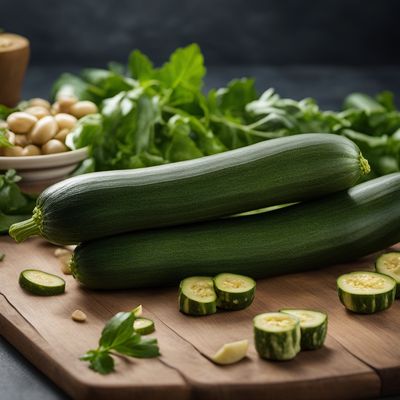
Ingredient
Courgettes and similar-
The Versatile Veggie: Unlocking the Potential of Courgettes and Similar
Courgettes are elongated, cylindrical vegetables with a smooth, glossy skin ranging in color from dark green to yellow. They have a crisp, yet tender texture and a subtly sweet taste that intensifies when cooked. Similar vegetables include yellow squash and pattypan squash, which share similar characteristics and culinary applications.
Origins and history
Courgettes have a long history dating back to ancient civilizations in Central and South America. They were introduced to Europe during the 16th century and gained popularity in Mediterranean cuisines. Today, they are widely cultivated and enjoyed in various culinary traditions worldwide.
Nutritional information
Courgettes are low in calories and rich in dietary fiber, vitamins A and C, potassium, and antioxidants. They also contain high water content, making them a hydrating and nutritious addition to meals.
Allergens
Courgettes and similar vegetables are generally well-tolerated and not known to cause common allergenic reactions. However, individuals with specific sensitivities or allergies to cucurbits, such as melons or cucumbers, should exercise caution and consult a healthcare professional if necessary.
How to select
When selecting courgettes, choose ones that are firm, smooth, and free from blemishes or soft spots. The skin should have a vibrant color and feel slightly glossy. Smaller courgettes tend to be more tender and flavorful.
Storage recommendations
To maintain the freshness of courgettes, store them in the refrigerator in a perforated plastic bag or a vegetable drawer. Avoid washing them until ready to use, as excess moisture can lead to spoilage. Use within a week for optimal quality.
How to produce
Courgettes and similar vegetables can be easily grown in home gardens or containers, as they are fast-growing and require minimal care. They thrive in well-drained soil and prefer warm, sunny conditions.
Preparation tips
Courgettes can be prepared in various ways, including grilling, roasting, sautéing, or even enjoyed raw in salads or as a crunchy snack. They can be spiralized into noodles, stuffed, or used as a base for fritters or vegetable medleys.
Substitutions
Yellow squash and pattypan squash can be used as suitable substitutes for courgettes, as they share a similar taste, texture, and culinary versatility.
Culinary uses
Courgettes and similar vegetables are widely used in Mediterranean, Middle Eastern, and American cuisines. They can be incorporated into pasta dishes, stir-fries, soups, stews, ratatouille, or even baked goods like bread or muffins.
Availability
Courgettes and similar vegetables are commonly available in most grocery stores and supermarkets worldwide. They are also cultivated in home gardens and can be found in farmers markets during the summer months.
More ingredients from this category

Pointed gourds
The Elegant Delicacy: Pointed Gourds

Courgettes
The Versatile Zucchini

Bottle gourds
The Versatile Gourd: Unveiling the Secrets of Bottle Gourds

Snake gourds
Serpentine Delights

Chayote fruits
The Versatile Chayote: A Hidden Gem in the Culinary World

Sopropos
The Versatile Gourd

Summer squashes
Versatile Delights of Summer

Ivy gourds
The Versatile Ivy Gourd: A Hidden Gem in the Culinary World

Angled luffas
The Versatile Vegetable: Angled Luffas
